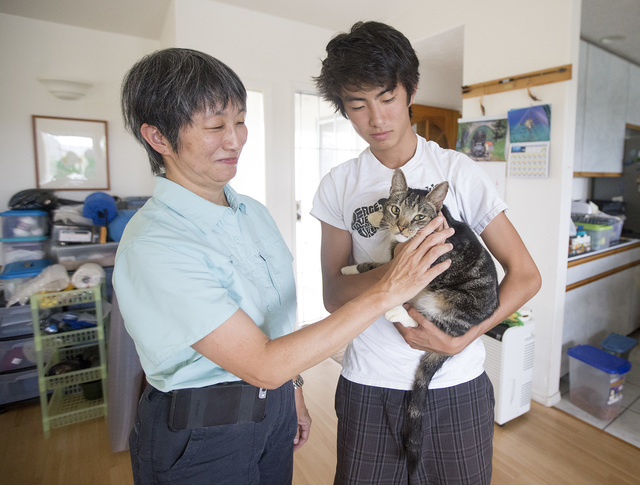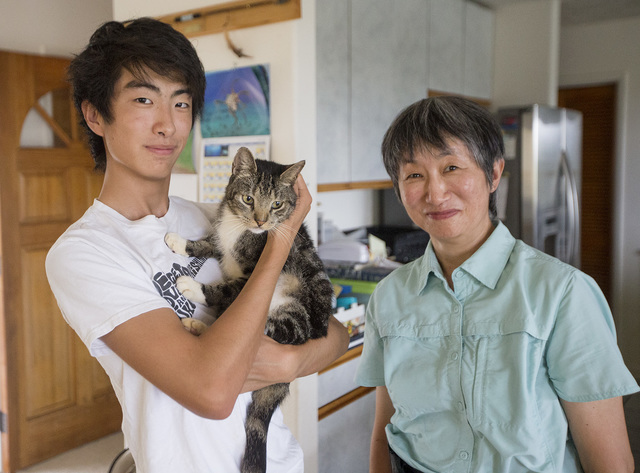Comeback kitty: Chip leads to return of Waiakea Uka family’s cat


Whether they’re miraculous or merely marvelous, Saeko Hayashi has a simple message: “Microchips work.”
Hayashi, an astronomer at the National Astronomical Observatory of Japan’s Subaru Telescope, wondered if she and her family would ever see their beloved cat, Teto, again. The neutered gray tabby, named after a pointy-eared anime character he resembles, was just a year old when he wandered away from the family’s Waiakea Uka home six years ago.
The cat is one of two Hayashi adopted together as kittens from the Hawaii Island Humane Society’s Keaau shelter. The other is a spayed black tortoiseshell female named Sakura, which means “cherry blossom.” She later rescued another gray tabby with white undercarriage from Liliuokalani Gardens in Hilo and named him Tito.
Hayashi said when Teto disappeared, she canvassed the neighborhood in a vain attempt to find him.
“He was part of my family, so we went around this block and farther down (the road),” she said. “We took the other cat with us, because she was a buddy to him. So if she showed some sign, sniffing or something, that was our hope. And also, we contacted the Humane Society, because he has this chip.”
Hayashi said she seeks out stories of pets reunited with owners after prolonged absences. She mentioned Bogie, a cat who went missing for 19 months after escaping his kennel while being boarded onto a United Cargo flight in Honolulu. A man who feeds feral cat colonies near Honolulu International Airport saw the friendly Siamese, suspected he was someone’s missing pet and had him scanned. Microchip information led to a joyful reunion in July between Bogie and his human family, who had moved to Detroit.
Then, on Monday, the doorbell rang at Hayashi’s house. She wasn’t home, but her son, Wataru, was.
“This lady’s standing here and she says, ‘Is Saeko there?’” the Waiakea High School senior said. “And I said, ‘No, my mother’s out.’ She said, ‘I found a cat. I took it to the Humane Society to see if it had a chip.’
“I went outside with her and she brought out the cat carrier and it was Teto inside. It was pretty amazing.”
The woman said she found the feline Aug. 30 near Nani Mau Gardens, about 3 miles from the Hayashi home as the crow flies.
“I was really surprised, because that’s kind of a long way,” Wataru Hayashi said.
Donna Whitaker, the Hawaii Island Humane Society’s executive director, confirmed the microchip scan, which happened on Monday since the Keaau shelter is closed on Sundays. She said there’s no record of the woman’s identity because the good Samaritan remained anonymous. Wataru Hayashi didn’t ask the woman for her name, but his mother is hoping to meet her.
“For her to bring the cat there then come back to find our house, that’s just amazing. Incredible,” Saeko Hayashi said. “I want to personally thank her and learn about how she found him.”
“Now that he’s back, I want to say we knew that he was alive and we kept hope that he was happy with some family. That was our hope,” she added. “Then, he came back, so that’s all good.”
As if on cue, Teto stretched out on the floor, a look resembling contentment on his face.
“Now, he does this,” Saeko Hayashi said, smiling. “At first, he didn’t do this because he was scared. It’s just amazing.
“You know, after six years, he was able to find a way home, thanks to that lady and thanks to the efforts of the Humane Society. First, they rescue the cats and dogs, they put the microchips in the cats and dogs and fix them. Then, in many cases, they find a home and live happily ever after.”
Whitaker said the chipping of pets has made stories such as Teto’s increasingly common.
“It happens frequently enough that we know the microchips work,” she said. “I was watching CNN the other day and they were talking about a dog that was reunited with its owner after about 12 years.”
Whitaker said the typical roaming range for a young neutered male cat is less than than a mile away from its home. It’s even less for older cats. So it’s uncommon, although not unheard of, for a neutered tom to wander several miles, she said.
“Cats, if they find someone who treats them well and someplace safe, they hang out there for a while and move on to the next place,” Whitaker said. “So they sort of somewhat adopt someone for a while but they look for their original owner. I think that’s always what’s in their mind. I know of a cat that was missing for a little less than two years that found its new home in Waikoloa. The people moved from Waimea and he found them in Waikoloa.”
In addition, Whitaker has the following advice to pet owners and would-be rescuers.
“If you find an animal, bring it to the shelter so its microchip can be scanned,” she said. “And keep your microchip information up to date. Can you imagine how awful it would have been if she had changed her phone or moved, and after six years we know who it belongs to and can’t reach her?
“That’s a biggie.”



